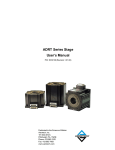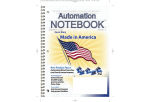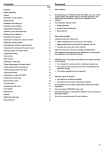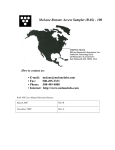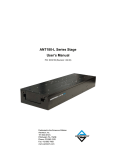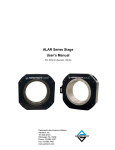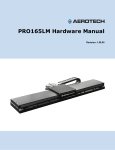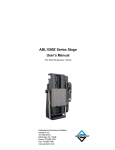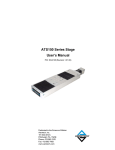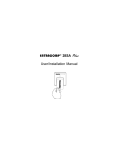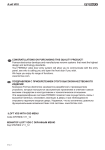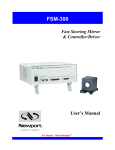Download EDS103_ACS and ACS LP Rotary Stages
Transcript
ACS and ACS LP Series Rotary Stages User’s Manual P/N: EDS103 (Revision 1.03.00) Dedicated to the Science of Motion Aerotech, Inc. 101 Zeta Drive, Pittsburgh, PA, 15238 Phone: 412-963-7470 Fax: 412-963-7459 www.aerotech.com Product Registration Register online at: http://www.aerotech.com/prodreg.cfm Technical Support United States Headquarters: Phone: (412) 967-6440 Fax: (412) 967-6870 Email: [email protected] United Kingdom: Phone: +44 118 940 9400 Fax: +44 118 940 9401 Email: [email protected] Germany: Phone: +49 911 967 9370 Fax: +49 911 967 93720 Email: [email protected] Japan: Phone: +81(0)47-489-1741 (Sales) Phone: +81(0)47-489-1742 (Service) Fax: +81(0)47-489-1743 Email: [email protected] China: Phone: +852-3793-3488 Email: [email protected] Revision History Revision 1.03.00 April 5, 2011 Revision 1.02.00 August 10, 2010 Revision 1.01.00 February 16, 2010 Revision 1.00.00 February 10, 2006 Product names mentioned herein are used for identification purposes only and may be trademarks of their respective companies. © Aerotech, Inc. 2011 ACS and ACS LP Stages User's Manual Table of Contents Table of Contents Table of Contents List of Figures List of Tables iii v vii Chapter 1: Overview 1 1.1. Standard Features 1.1.1. ACS Optional Features 1.1.2. Model Numbers 1.2. Dimensions 1.3. Safety Procedures and Warnings 1.4. EC Declaration of Incorporation Chapter 2: Installation 2.1. Unpacking and Handling the Stage 2.2. Preparing the Mounting Surface 2.3. Securing the Stage to the Mounting Surface 2.4. Attaching the Payload to the Stage 2.5. Electrical Installation 2.6. Air Requirements Chapter 3: Operating Specifications 3.1. Environmental Specifications 3.2. ACS Basic Specifications 3.3. ACS LP Basic Specifications 3.4. Limit Switch Wiring 3.5. Standard Motor Wiring 3.6. Vacuum Operation Chapter 4: Maintenance 4.1. Service and Inspection Schedule 4.2. Cleaning and Lubrication 4.2.1. Collet and Collet Chuck Lubrication and Cleaning 4.3. Seal Replacement 4.3.1. Piston Seal Change Procedure 4.3.2. Ringseal O-ring Replacement (ACS Only) 4.3.3. Rotary Union Seals for Three-Jaw Gripper Stages (ACS Only) 4.3.4. Water Jacket Seal Replacement (ACS Only) 4.4. Changing ACS and ACS LP Workholding Devices 4.4.1. Availible Workholding Devices 4.4.2. Collet Change Procedure 4.4.3. Changing Collet Chucks (ACS Only) 4.4.4. Gripper Configurations (ACS Only) 2 3 4 7 13 15 17 17 18 19 21 21 22 23 23 24 29 31 32 36 37 37 37 38 39 39 42 44 46 48 48 48 50 52 Appendix A: Warranty and Field Service 55 Appendix B: Technical Changes 57 Index 59 Reader's Comments 61 www.aerotech.com iii Table of Contents iv ACS and ACS LP Stages User's Manual www.aerotech.com ACS and ACS LP Stages User's Manual List Of Figures List of Figures Figure 1-1: Figure 1-2: Figure 1-3: Figure 1-4: Figure 1-5: Figure 1-6: Figure 1-7: Figure 1-8: Figure 2-1: Figure 2-2: Figure 2-3: Figure 3-1: Figure 3-2: Figure 3-3: Figure 4-1: Figure 4-2: Figure 4-3: Figure 4-4: Figure 4-5: Figure 4-6: Figure 4-7: Figure 4-8: Figure 4-9: Figure 4-10: Figure 4-11: Figure 4-12: Figure 4-13: Figure 4-14: Figure 4-15: Figure 4-16: ACS-150 Rotary Stage with ER Collet and Three-Jaw Gripper ACS-100 Dimensions ACS-150-ER Dimensions ACS-150-3J Dimensions ACS-200-3J Dimensions ACS-100LP Dimensions ACS-150LP Dimensions ACS-200LP Dimensions Results of Flat Versus Non-Flat Mounting Front view of a Typical ACS-150 Stage Showing End Mounting Holes Typical ACS-150 Stage Showing Side Mounting Holes and T-Slot Detail Standard Wiring Connectors for ACS-150/200 and ACS-150LP/200LP Stages Standard Wiring Connectors for ACS-100 and ACS-100LP Stages Optional Wiring Connectors for ACS-100 Stages Exploded View of Collet Assembly Piston Seal Installation Procedure Cross-section View of Piston Showing Seal Orientation Typical Ringseal with O-ring Installed Ringseal Removal Tool Dimensions Cross-section View of Ringseal Showing Both O-rings Exploded Drawing of Rear Seal Components Cross-section View of Rear Seal Showing Seal Orientations Exploded View of Water Jacket Housing Assembly Cross-section View of Water Jacket Seal Showing Seal Orientation Schematic of Collet Insertion Into and Removal from Collet Nut Installation Procedure for Collet Exploded View of Collet Assembly Gripper Mounting Hole Locations in ACS and ACS LP Shaft Mounting Holes for Three-Jaw Gripper Air Inlets in Three-Jaw Grippers www.aerotech.com 3 7 8 9 10 11 11 12 18 19 20 32 33 34 39 41 41 42 43 43 44 45 46 47 49 49 50 52 53 53 v List of Figures vi ACS and ACS LP Stages User's Manual www.aerotech.com ACS and ACS LP Stages User's Manual List of Tables List of Tables Table 1-1: Table 1-2: Table 3-1: Table 3-2: Table 3-3: Table 3-4: Table 3-5: Table 3-6: Table 3-7: Table 3-8: Table 3-9: Table 3-10: Table B-1: Table B-2: ACS Model Numbering System ACS LP Model Numbering System Environmental Specifications ACS-100 Series Specifications ACS-150 Series Specifications ACS-200 Series Specifications ACS Series Resolution Information ACS Motor Specifications ACS LP Series Specifications ACS LP Maximum Encoder Frequency ACS LP Motor Specifications Motor Wiring Pinout Descriptions Current Changes (1.03.00) Archived Changes www.aerotech.com 4 6 23 24 25 26 27 28 29 30 30 35 57 58 vii List of Tables viii ACS and ACS LP Stages User's Manual www.aerotech.com ACS and ACS LP Stages User's Manual Overview Chapter 1: Overview Aerotech’s ACS and ACS LP series rotary stages with integrated ER collet chuck or 3-jaw gripper configuration provide automated material handling capability for a wide range of materials and applications. This manual describes Aerotech’s ACS and ACS LP series direct drive rotary positioning stages. This chapter introduces standard and optional features of the ACS and ACS LPstages, explains the model numbering system, and gives general safety precautions. www.aerotech.com Chapter 1 1 Overview ACS and ACS LP Stages User's Manual 1.1. Standard Features All ACS and ACS LP stages come standard with a direct drive brushless motor. An integral non-contact rotary union is standard on the ACS-100, ACS-100LP, ACS-150, and ACS-150LP stages. These features combine to create a low friction, low maintenance rotary stage capable of high accelerations and low positioning error. With a non-contact rotary union, there are no seals to be replaced or lubricated allowing for a lifetime of maintenance free performance. The brushless, slotless motor design is useful for applications requiring good velocity control, as it allows for smooth rotation without the presence of a torque ripple. There are no brushes to wear, no belts to tension, and no gears to wear resulting in a completely maintenance-free motor. All ACS LP stages come standard with ER collet chucking. 2 Chapter 1 www.aerotech.com ACS and ACS LP Stages User's Manual Overview 1.1.1. ACS Optional Features The ACS series stages can be equipped with an integrated ER collet chuck or a three-jaw gripper chuck. See Table 1-1 for more information regarding available options for each stage. Both the ACS-100 and ACS-150 have available ER collet chucks. Collets are available from machine-tool component suppliers in sizes that support tube diameters from 0.5 mm to 30 mm. The collet is retained with a threaded collet nut enabling quick-changeover. It is configured in a “fail-safe” normally-closed mode where full clamping force is applied when no air pressure is present. The ACS-100 accepts an ER8 collet capable of holding tube diameters from 0.5 mm to 5.0 mm. The ACS-150 can be configured to accept either ER25 or ER40 series collets. Aerotech recommends using an ER25 collet for holding requirements of 1 mm to 16 mm and using an ER40 collet for holding requirements of 15.5 mm to 30 mm. The ER25 also has an optional sealed “water-jacket” configuration that can be used for fluid delivery in wet laser cutting applications. N O T E : While the ER40 collet can support tubes up to 30 mm in diameter, tubes greater than 24.5 mm in diameter cannot extend more than 70 mm below the top of the collet. Both the ACS-150 and ACS-200 support three-jaw grippers with clear apertures for product feed-through. All gripper assemblies are configurable as either normally-open or normally-closed with various jaw strokes to support a wide range of material sizes. The gripper can be fitted with custom jaws for the handling of materials with non-round profiles such as square or hexagonal bar stock. The normally-open and normally-closed options also provide the ability to grip either the O.D. or I.D. of the material. Figure 1-1: www.aerotech.com ACS-150 Rotary Stage with ER Collet and Three-Jaw Gripper Chapter 1 3 Overview ACS and ACS LP Stages User's Manual 1.1.2. Model Numbers The stage model number indicates the optional features on a particular stage. To determine the options on your stage, refer to Table 1-1 for an explanation of the ACS numbering system and Table 1-2 for an explanation of the ACS LP numbering system. Example: ACS-150-115-3J-12-AS-NC-10-NS This designates an ACS and ACS LP-150 stage with 150 mm direct drive motor, 1 Vpp amplified sine position transducer, normally closed 10 mm stroke three-jaw gripper, and no rear seal. The table below lists the available options in the order they appear in the example above. Aerotech continually improves its product offerings, and listed options may be superseded at any time. Refer to the most recent edition of the Aerotech Motion Control Product Guide for the most current product information at www.aerotech.com. Table 1-1: ACS Model Numbering System ACS Series Direct Drive Rotary Stage ACS Direct-drive rotary stage with integral pneumatic collet chuck or 3-jaw gripper and rotary union. Frame Size -100-85 100 mm diameter direct drive rotary stage with 0.4 N-m continuous torque and integral rotary union -100-135 100 mm diameter direct drive rotary stage with 1.9 N-m continuous torque and integral rotary union -150-115 150 mm diameter direct drive rotary stage with 3.6 N-m continuous torque and integral rotary union -150-135 150 mm diameter direct drive rotary stage with 6.5 N-m continuous torque and integral rotary union -150-185 150 mm diameter direct drive rotary stage with 11.4 N-m continuous torque and integral rotary union -200-155 200 mm diameter direct drive rotary stage with 16.9 N-m continuous torque and integral rotary union -200-285 200 mm diameter direct drive rotary stage with 24.9 N-m continuous torque and integral rotary union Fixture Type 4 -ER8 Air-actuated ER8 collet holder, normally closed, supports tube diameters from 0.5 mm to 5 mm; only available on ACS-100-XXX -ER25 Air-actuated ER25 collet holder, normally closed, supports tube diameters from 1 mm to 16 mm; only available on ACS-150-XXX -ER40 Air-actuated ER40 collet holder, normally closed, supports tube diameters from 15.5 mm to 30 mm; only available on ACS-150-XXX -3J-12 Air-actuated 3-jaw gripper with 12 mm clear aperture, ±20 micron repeatability; available on ACS-150 and ACS-200 -3J-25 Air-actuated 3-jaw gripper with 25 mm clear aperture, ±20 micron repeatability; only available on ACS-200 Chapter 1 www.aerotech.com ACS and ACS LP Stages User's Manual Overview Table 1-1: Model Numbering System (continued) Position Transducer (1) -AS 1 Vpp sine wave output; 360 arc-sec resolution on ACS-150 and 240 arc-sec resolution on ACS-200 -X5 Square wave digital output; 18 arc-sec resolution on ACS-150 and 12 arc-sec resolution on ACS-200 -X10 Square wave digital output; 9 arc-sec resolution on ACS-150 and 6 arc-sec resolution on ACS200 -X25 Square wave digital output; 3.6 arc-sec resolution on ACS-150 and 2.4 arc-sec resolution on ACS-200 -X50 Square wave digital output; 1.8 arc-sec resolution on ACS-150 and 1.2 arc-sec resolution on ACS-200 Gripper Options(2) -NC-10 Normally closed 3J-12 gripper with 10 mm jaw stroke, 240 N (52 lb) peak grip force -NO-10 Normally open 3J-12 gripper with 10 mm jaw stroke, 240 N (52 lb) peak grip force -NC-13 Normally closed 3J-25 gripper with 13 mm jaw stroke, 450 N (102 lb) peak grip force -NO-13 Normally open 3J-25 gripper with 13 mm jaw stroke, 450 N (102 lb) peak grip force -NC-16 Normally closed 3J-12 gripper with 16 mm jaw stroke, 150 N (33 lb) peak grip force -NO-16 Normally open 3J-12 gripper with 16 mm jaw stroke, 150 N (33 lb) peak grip force -NC-20 Normally closed 3J-25 gripper with 20 mm jaw stroke, 270 N (60 lb) peak grip force -NO-20 Normally open 3J-25 gripper with 20 mm jaw stroke, 270 N (60 lb) peak grip force ER Collet Seal Options -NS No rear seal (standard) -S Rear shaft seal -W Water jacket assembly for wet cutting applications; seal diameter specified with Water Jacket Seal option; only available with ER25 collet configuration. ER Collet Size -XX-YYMM Electro-polished DIN6499AA ER style collet; supports tube diameters from XX to YY mm Water Jacket Seal -X.XXMM Water jacket seal assembly for nominal tube diameter X.XX mm; consult factory for available sizes Tooling -WRENCH Spanner wrench set for changing ER collet Air Purge -AP Air purge fitting to positive pressurize ACS stage to limit ingress of airborne particulates Connector options for ACS-100 -HPD 4 pin D-style motor power and 25 pin D-style feedback -25D 25 pin D-style motor power and 25 pin D-style feedback (1) Digital output encoder signals are synthesized with a 16 MHz clock. Care must be taken to ensure that the encoder sample rate on the controller is at least 16 MHz or higher. Slower clock rates are available on request. (2) Available only with 3-jaw gripper option. www.aerotech.com Chapter 1 5 Overview Table 1-2: ACS and ACS LP Stages User's Manual ACS LP Model Numbering System ACS LP Series Direct Drive Rotary Stage ACS Direct-drive rotary stage with integral pneumatic collet chuck Frame Size and Fixture Type Frame Size and Fixture Type -100LP 100 mm wide direct-drive rotary stage with 1.8 N-m peak torque output and integral rotary union, air-actuated ER8 (1) collet holder, normally closed, supports tube diameters from 0.7 mm to 5 mm -150LP 150 mm wide direct-drive rotary stage with 11.7 N-m peak torque output and integral rotary union, air-actuated ER25 (1) collet holder, normally closed, supports tube diameters from 1 mm to 16 mm -200LP 200 mm wide direct-drive rotary stage with 30 N-m peak torque output and integral rotary union, air-actuated ER40 (1) collet holder, normally closed, supports tube diameters from 16 mm to 30 mm. Tubes with a diameter greater than 24.5 mm cannot extend more than 70 mm below the top of the collet. Winding Options -A Standard motor winding -B Optional motor winding (consult Aerotech for availability) Position Transducer -AS Standard feedback device; 1 Vpp sine wave output; 360 arc-sec resolution on ACS-100LP and 240 arc-sec on ACS-150/200LP -X5(2) Square wave digital output; 18 arc-sec resolution on ACS-100LP and 6 arc-sec resolution on ACS-150/200LP -X10(2) Square wave digital output; 9 arc-sec resolution on ACS-100LP and 3 arc-sec resolution on ACS-150/200LP -X25(2) Square wave digital output; 3.6 arc-sec resolution on ACS-100LP and 2.4 arc-sec resolution on ACS-150/200LP -X50(2) Square wave digital output; 1.8 arc-sec resolution on ACS-100LP and 1.2 arc-sec resolution on ACS-150/200LP Construction Options -WRENCH SET Spanner wrench for changing ER collets -XMM DIN6499 AA collet. Consult factory for available sizes (1) Collet holder requires dry (0°C dewpoint), oil-less, filtered air (0.25 micron) or 99.99% pure filtered nitrogen (0.25 micron). (2) Requires a controller with a 16 MHz encoder sample rate. 6 Chapter 1 www.aerotech.com ACS and ACS LP Stages User's Manual Overview 1.2. Dimensions Figure 1-2: www.aerotech.com ACS-100 Dimensions Chapter 1 7 Overview ACS and ACS LP Stages User's Manual Figure 1-3: 8 ACS-150-ER Dimensions Chapter 1 www.aerotech.com ACS and ACS LP Stages User's Manual Figure 1-4: www.aerotech.com Overview ACS-150-3J Dimensions Chapter 1 9 Overview ACS and ACS LP Stages User's Manual Figure 1-5: 10 ACS-200-3J Dimensions Chapter 1 www.aerotech.com ACS and ACS LP Stages User's Manual www.aerotech.com Figure 1-6: ACS-100LP Dimensions Figure 1-7: ACS-150LP Dimensions Chapter 1 Overview 11 Overview ACS and ACS LP Stages User's Manual Figure 1-8: 12 ACS-200LP Dimensions Chapter 1 www.aerotech.com ACS and ACS LP Stages User's Manual Overview 1.3. Safety Procedures and Warnings The following statements apply throughout this manual. Failure to observe these precautions could result in serious injury to those performing the procedures and damage to the equipment. This manual and any additional instructions included with the stage should be retained for the lifetime of the stage. To minimize the possibility of electrical shock and bodily injury or death, disconnect all electrical power prior to making any electrical connections. To minimize the possibility of electrical shock and bodily injury or death when any electrical circuit is in use, ensure that no person comes in contact with the circuitry when the stage is connected to a power source. To minimize the possibility of bodily injury or death, disconnect all electrical power prior to making any mechanical adjustments. Moving parts of the stage can cause crushing or shearing injuries. All personnel must remain clear of any moving parts. Improper use of the stage can cause damage, shock, injury, or death. Read and understand this manual before operating the stage. If the stage is used in a manner not specified by the manufacturer, the protection provided by the stage can be impaired. Stage cables can pose a tripping hazard. Securely mount and position all stage cables to avoid potential hazards. www.aerotech.com Chapter 1 13 Overview ACS and ACS LP Stages User's Manual Do not expose the stage to environments or conditions outside the specified range of operating environments. Operation in conditions other than those specified can cause damage to the equipment. The stage must be mounted securely. Improper mounting can result in injury and damage to the equipment. Use care when moving the stage. Manually lifting or transporting stages can result in injury. Only trained personnel should operate, inspect, and maintain the stage. This stage is intended for light industrial manufacturing or laboratory use. Use of the stage for unintended applications can result in injury and damage to the equipment. Before using this stage, perform an operator risk assessment to determine the needed safety requirements. 14 Chapter 1 www.aerotech.com ACS and ACS LP Stages User's Manual Overview 1.4. EC Declaration of Incorporation Manufactorer: Aerotech, Inc. 101 Zeta Drive Pittsburgh, PA 15238 USA herewith declares that the product: Aerotech, Inc. ACS and ACS LP Stage is intended to be incorporated into machinery to constitute machinery covered by the Directive 2006/42/EC as amended; does therefore not in every respect comply with the provisions of this directive; and that the following harmonized European standards have been applied: EN ISO 12100-1,-2:2003+A1:2009 Safety of machinery - Basic concepts, general principles for design ISO 14121-1:2007 Safety of machinery - Risk assessment - Par 1: Principles EN 60204-1:2005 Safety of machinery - Electrical equipment of machines - Part 1: General requirements and further more declares that it is not allowed to put the equipment into service until the machinery into which it is to be incorporated or of which it is to be a component has been found and declared to be in conformity with the provisions of the Directive 2006/42/EC and with national implementing legislation, i.e. as a whole, including the equipment referred to in this Declaration. Authorized Representative: Address: Manfred Besold AEROTECH GmbH Süd-West-Park 90 D-90449 Nürnberg Name: Position: Location: Date: www.aerotech.com Alex Weibel / Engineer Verifying Compliance Pittsburgh, PA April 5, 2011 Chapter 1 15 Overview 16 ACS and ACS LP Stages User's Manual Chapter 1 www.aerotech.com ACS and ACS LP Stages User's Manual Installation Chapter 2: Installation This chapter describes the installation procedure for the ACS and ACS LP stages, including handling the stage properly, preparing the mounting surface to accept the stage, securing the stage to the mounting surface, attaching the payload, and making the electrical connections. Installation must follow the instructions in this chapter. Failure to follow these instruction could result in injury and damage to the equipment. 2.1. Unpacking and Handling the Stage Carefully remove the stage from the protective shipping container. Use compressed nitrogen or clean, dry air to remove any dust or debris that has collected during shipping. Before operating the stage, it is important to let the stage stabilize at room temperature for at least 12 hours. This soak-out time is required because of thermal expansion and contraction of the parts used to build the stage. Allowing the stage to stabilize at room temperature will ensure that all of the alignments, preloads, and tolerances are the same as they were when tested at Aerotech. Set the stage on a smooth, flat, and clean surface. Each stage has a label listing the system part number and serial number. These numbers contain information necessary for maintaining or updating system hardware and software. Locate this label and record the information for later reference. If any damage has occurred during shipping, report it immediately. Improper stage handling could adversely affect the stage’s performance. Use care when moving the stage. Manually lifting or transporting stages can cause injury. Lift the stage only by the base. Do not use the ballscrew or motor as lifting points. www.aerotech.com Chapter 2 17 Installation ACS and ACS LP Stages User's Manual 2.2. Preparing the Mounting Surface The mounting surface should be flat and have adequate stiffness in order to achieve the maximum performance from the ACS and ACS LP. When an ACS or ACS LP series stage is mounted to a non-flat surface, the stage can be distorted as the mounting screws are tightened. This distortion will decrease the overall accuracy of the stage. To maintain accuracy, the mounting surface should be flat within 1 µm per 25 mm. Adjustments to the mounting surface must be done before the stage is secured. The effects of flatness on mounting are illustrated in Figure 2-1. Figure 2-1: Results of Flat Versus Non-Flat Mounting N O T E : The stage base is precision machined and verified for flatness prior to stage assembly at the factory. If machining is required to achieve the desired flatness, it should be performed on the mounting surface rather than the stage base. Shimming should be avoided if possible. If shimming is required, it should be minimized to improve the rigidity of the system. 18 Chapter 2 www.aerotech.com ACS and ACS LP Stages User's Manual Installation 2.3. Securing the Stage to the Mounting Surface ACS and ACS LP series stages have numerous mounting holes available to secure the stage to the mounting surface. Figure 2-2 shows the mounting holes at the rear of the stage. On ACS-150, ACS-150LP, ACS-200 and ACS-200LP stages, these are 7 mm diameter holes designed for either 6 mm or ¼ inch socket head cap screws. The sides of the stage are equipped with several M6 x 1.0 tapped holes. Eight T-slots are included as a standard feature on the ACS-150, ACS-150LP, ACS-200 and ACS-200LP models. The dimensions of these T-slots are identical for ACS-150, ACS-150LP, ACS-200 and ACS-200LP stages and are detailed in Figure 2-3. On ACS-100 and ACS-100 LP stages, the rear mounting holes are designed for either a 5 mm or #10 socket head cap screw, and the side holes are tapped M5 x 0.8 x 5 mm deep. T-slots are not available on the ACS100 and ACS-100 LP series stages. Figure 2-2 and Figure 2-3 show ACS stages. On ACS LP stages, the mounting holes are located in equivalent places. The stage must be mounted securely. Improper mounting can result in injury and damage to the equipment. Figure 2-2: www.aerotech.com Front view of a Typical ACS-150 Stage Showing End Mounting Holes Chapter 2 19 Installation Figure 2-3: 20 ACS and ACS LP Stages User's Manual Typical ACS-150 Stage Showing Side Mounting Holes and T-Slot Detail Chapter 2 www.aerotech.com ACS and ACS LP Stages User's Manual Installation 2.4. Attaching the Payload to the Stage To prevent damage to the stage or parts, test the operation of the stage before any material is held in the collet or gripper. Proceed with the electrical installation and test the motion control system in accordance with the system documentation. Document all results for future reference. For information on electrical connections, refer to the documentation of the motion control system or the wiring drawings in Chapter 3: Operating Specifications. To operate the collet, clean compressed air or nitrogen must be supplied to the stage. The one-touch air inlet fitting accepts ¼ inch OD plastic airline. Simply push the airline into the fitting and supply air to the stage. Aerotech can provide valves, fittings, and airlines to create a custom collet system. Contact the factory for more details. Once air is supplied, material of the appropriate size can be placed in the collet. All collets supplied by Aerotech are clearly labeled with their clamping size range and collet style. Be sure to use only the correct size material in the collet. The accuracy of the collet could be compromised if the incorrect material size is clamped. Never clamp material or tools that are larger than the specified range. It is also important to have the material or tool inserted at least 2/3 the length of the collet bore. Any less than this could cause permanent deformation of the collet and reduce accuracy. 2.5. Electrical Installation Aerotech motion control systems are adjusted at the factory for optimum performance. When the ACS or ACS LP series stage is part of a complete Aerotech motion control system, setup involves connecting the stage to the appropriate drive chassis with the cables provided. Connect the provided cables to the feedback and motor connectors on the stage. Labels on the drive indicate the appropriate connections. Refer to the appropriate drive manuals and documentation for additional installation and operation information. In some cases, if the system is uniquely configured, a drawing showing system interconnects is supplied. See Section 3.5. for more information on the electrical connections on the ACS and ACS LP stages. Never connect or disconnect any electrical component or connecting cable while power is applied, or serious damage may result. If you are using cables other than those provided by Aerotech, you must connect the pin in the motor connector carrying the stage's protective ground (shown in Section 3.5. ) to a ground connection. www.aerotech.com Chapter 2 21 Installation ACS and ACS LP Stages User's Manual 2.6. Air Requirements The air pressure supplied to the collet holder or gripper is important in ensuring that the material or tool is released properly, or for the optional normally-open (NO) gripper (ACS only), that the material is held securely. If compressed air is used, it must be filtered to 0.25 microns, dry to 0º F dew point, and oil free. If nitrogen is used, it must be 99.99 percent pure and filtered to 0.25 microns. For stages equipped with a threejaw gripper, air must be regulated to between 3 and 7 bar (45 and 100 psig). Higher pressures could cause damage to the gripper assembly and should be avoided. For stages equipped with an ER collet chuck, the chuck becomes fully open at approximately 4-7 bar (60-100 psig) depending on the collet size. Higher pressures will not cause damage to the rotary union, but high flow rates will result. Because of the noncontact rotary union design on collet-equipped stages, a small amount of leakage will occur. Approximate leakage rates of between 10 Lpm (0.5 CFM) and 40 Lpm (1.4 CFM), depending on pressure, will be observed when the collet is open. 22 Chapter 2 www.aerotech.com ACS and ACS LP Stages User's Manual Operating Specifications Chapter 3: Operating Specifications This chapter contains general technical information about ACS and ACS LP series stages. Included are basic product specifications, load capacities and ratings, and motor wiring diagrams. 3.1. Environmental Specifications The environmental specifications for the ACS and ACS LP are listed in the following table. Table 3-1: Environmental Specifications Ambient Temperature Operating: 10° to 35° C (50° to 95° F) The optimal operating temperature is 20° C ±2° C (68° F ±4° F). If at any time the operating temperature deviates from 20° C degradation in performance could occur. Contact Aerotech for information regarding your specific application and environment. Storage: 0° to 40° C (32° to 104° F) in original shipping packaging Humidity Operating: 40 percent to 60 percent RH The optimal operating humidity is 50 percent RH. Storage: 30 percent to 60 percent RH, non-condensing in original packaging Altitude Operating: 0 to 2,000 m (0 to 6,562 ft) above sea level Contact Aerotech if your specific application involves use above 2,000 m or below sea level. Vibration Use the system in a low vibration environment. Excessive floor or acoustical vibration can affect stage and system performance. Contact Aerotech for information regarding your specific application. Dust Exposure The ACS and ACS LP stages are not suited for dusty or wet environments. This equates to an ingress protection rating of IP00. Use Indoor use only Do not expose the stage to environments or conditions outside the specified range of operating environments. Operation in conditions other than those specified can cause damage to the equipment. www.aerotech.com Chapter 3 23 Operating Specifications ACS and ACS LP Stages User's Manual 3.2. ACS Basic Specifications ACS series rotary stage specifications are shown in Table 3-2, Table 3-3, and Table 3-4. Encoder resolution information is given in Table 3-5. Motor specifications are given in Table 3-6. Table 3-2: ACS-100 Series Specifications ACS Series Total Travel ACS-100-85 Gripper/Collet Option Three-Jaw Grippler Travel ER8 3J-12 NA 3J-25 Torque Output Continuous Current, Stall ACS-100-135 ±360° Continuous NA Peak 1.8 Nm 7.84 Nm Continuous 0.4 Nm 1.96 Nm Apk 2 3.7 Arms 1.43 2.6 Accuracy ±72.7 µrad (±15 arc sec) Repeatability ±29 µrad (±6 arc sec) Axial Runout ±15 µrad Radial Runout ±15 µrad Wobble Aperture ±48.5 µrad (±10 arc sec) ER8 5 mm ER25 ER25, ER40, 3J-12, and 3J-25 are not applicable ER40 NA 3J-12 NA 3J-25 NA Resolution 0.87-87.3 µrad (0.18-18 arc sec) Moment Load 30 Nm Axial Load 10 kg Rated Speed Motor Type 24 800 rpm S-76-35-A Chapter 3 S-76-85-A www.aerotech.com ACS and ACS LP Stages User's Manual Table 3-3: Operating Specifications ACS-150 Series Specifications ACS Series Total Travel ACS-150-115 Gripper/Collet Option Three-Jaw Grippler Travel Continuous Current, Stall 10 mm, 16 mm NA Peak 14.4 Nm 26 Nm 37.2 Nm Continuous 3.6 Nm 6.5 Nm 11.4 Nm Apk 3.8 3.4 3.1 Arms 2.7 2.4 2.2 Accuracy ±72.7 µrad (±15 arc sec) Repeatability ±29 µrad (±6 arc sec) Axial Runout ±15 µrad Radial Runout ±15 µrad Wobble Aperture ±48.5 µrad (±10 arc sec) ER8 NA ER25 16 mm ER40 30 mm 3J-12 12 mm 3J-25 NA Resolution 0.87-87.3 µrad (0.18-18 arc sec) Moment Load 188 Nm Axial Load 30 kg Rated Speed Motor Type www.aerotech.com ACS-150-180 ER25, ER40, 3J-12 3J-12 3J-25 Torque Output ACS-150-135 ±360° Continuous 600 rpm S-130-39-A Chapter 3 S-130-60-A S-130-81-A 25 Operating Specifications Table 3-4: ACS and ACS LP Stages User's Manual ACS-200 Series Specifications ACS Series Total Travel ACS-200-155 ACS-200-185 ±360° Continuous Gripper/Collet Option Three-Jaw Grippler Travel 3J-12, #j-25 3J-12 10 mm, 16 mm 3J-25 Torque Output Continuous Current, Stall 13 mm, 20 mm Peak 69.2 Nm 99.6 Nm Continuous 16.9 Nm 24.9 Nm Apk 5.1 4.9 Arms 3.6 3.5 Accuracy ±72.7 µrad (±15 arc sec) Repeatability ±29 µrad (±6 arc sec) Axial Runout ±30 µrad Radial Runout ±30 µrad Wobble Aperture ±72.7 µrad (±26 arc sec) ER8 NA ER25 NA ER40 NA 3J-12 12 mm 3J-25 Resolution 25 mm 0.87-87.3 µrad (0.18-18 arc sec) Moment Load 425 Nm Axial Load 140 kg Rated Speed 500 rpm Motor Type 26 S-180-69-A Chapter 3 S-180-94-A www.aerotech.com ACS and ACS LP Stages User's Manual Table 3-5: Stage ACS-100 ACS-150 ACS-200 Operating Specifications ACS Series Resolution Information Position Transducer -AS Counts per Revolution 3600 Interpolation Factor 1 Resolution Arc Sec 360.0 (2) µrad 1745.3 (2) -X5 3600 5 18.0 (1) 87.3 (1) -X10 3600 10 9.0 (1) 43.6 (1) (1) 17.5 (1) -X25 3600 25 3.6 -X50 3600 50 1.8 (1) 8.7 (1) (2) 1745.3 (2) -AS 3600 1 360.0 -X5 3600 5 18.0 (1) 87.3 (1) -X10 3600 10 9.0 (1) 43.6 (1) (1) 17.5 (1) -X25 3600 25 3.6 -X50 3600 50 1.8 (1) 8.7 (1) (2) -AS 5400 1 240.0 -X5 5400 5 12.0 (1) 29.1 (1) 11.6 (1) 5400 10 6.0 -X25 5400 25 2.4 (1) 50 (1) 5400 1.2 58.2 (1) (1) -X10 -X50 1163.6 (2) 5.8 (1) (1) Assumes quadrature (x4) interpolation by controller. (2) Amplified Sine resolution depends on controller multiplier used. N O T E : The encoders used on all ACS series stages come standard with a 16 MHz clock rate. Aerotech can provide slower or faster clock rates to match the controller being used. Consult the factory for more information. www.aerotech.com Chapter 3 27 Operating Specifications Table 3-6: ACS and ACS LP Stages User's Manual ACS Motor Specifications Model Winding Designation S-7635 S-7685 S-13039 S-13060 S-13081 S-18069 S-18094 -A -A -A -A -A -A -A Performance Specifications (1,5) Stall Torque, Continuous (2) N-m 0.53 1.60 2.36 4.18 5.89 11.12 15.93 in-lb 75.0 227.0 20.9 37.0 52.1 98.4 141.0 N-m 2.12 6.41 9.42 16.73 23.55 44.47 63.70 Peak Torque (3) in-lb 300.0 908.0 83.4 148.1 208.5 393.7 563.9 Rated Speed rpm 3,000 3,000 2,000 1,000 750 500 250 Rated Power Output, Continuous watts 166.3 381.2 493.4 437.9 462.4 582.1 416.9 Volts pk / krpm 32.1 57.0 75.1 148.9 222.7 263.9 393.4 3.80 3.8 3.4 3.2 5.1 4.9 Electrical Specifications (5) BEMF Constant (line to line, max) Continuous Current, Stall (2) Amp pk 2.0 Amp rms 1.4 2.7 2.7 2.4 2.3 3.6 3.5 Peak Current, Stall (3) Amp pk 8.0 15.2 15.2 13.6 12.8 20.4 19.6 Amp rms 5.7 10.7 10.7 9.6 9.1 14.4 13.9 N-m / Amp pk 0.26 0.42 0.62 1.23 1.84 2.18 3.25 in-lb / Amp pk 37.5 59.7 5.5 10.9 16.3 19.3 28.8 N-m / Amp rms 0.37 0.60 0.88 1.74 2.60 3.08 4.60 in-lb / Amp rms 53.0 84.5 7.8 15.4 23.0 27.3 40.7 N-m / √W 0.083 0.179 0.265 0.446 0.586 1.053 1.391 Resistance, 25 °C (line to line) ohms 10.5 5.7 5.6 7.8 10.1 4.4 5.6 Inductance (line to line) mH 1.40 1.10 1.70 1.80 2.80 1.70 2.60 Torque Constant (4,9) Motor Constant (2,4) Maximum Bus Voltage Thermal Resistance Number of Poles VDC 340 340 340 340 340 340 340 °C / W 1.83 0.93 0.95 0.85 0.74 0.67 0.57 P 14 14 18 18 18 18 18 (1) Performance is dependent upon heat sink configuration, system cooling conditions, and ambient temperature (2) Values shown @ 75 °C rise above a 25 °C ambient temperature, with housed motor mounted to a 330 mm x 330 mm x 13 mm aluminum heat sink (3) Peak torque assumes correct rms current, consult Aerotech (4) Torque Constant and Motor Constant specified at stall (5) All performance and electrical specifications +/- 10% (6) Losses due to bearings and aerodynamics considered negligible (7) Maximum winding temperature is 100 °C, Thermistor trips at 100 °C (8) Ambient operating temperature range: 0 °C - 25 °C, consult Aerotech for performance in elevated ambient temperatures (9) All Aerotech amplifiers are rated Apk; use torque constant in N-m / Apk when sizing 28 Chapter 3 www.aerotech.com ACS and ACS LP Stages User's Manual Operating Specifications 3.3. ACS LP Basic Specifications ACS LP series rotary stage specifications are shown in 3.3 and ACS LP series stage maximum encoder frequencies are given in Table 3-8. Motor specifications are given in Table 3-9. Table 3-7: ACS LP Series Specifications Model Total Travel ACS-100LP Collet Option(1,2) Width Tabletop Diameter Aperture ER8 ER25 ER40 100 mm 150 mm 200 mm 95 mm 140 mm 190 mm 5 mm NA NA ER25 NA 16 mm NA ER40 NA NA 25 mm S-76-35-A/S-76-35B S-130-39-A/S-13039-B S-180-44-A/S-18044-B Bus Voltage Up to 320 VDC Continuous Current, Stall A pk A rms Resolution Accuracy 1.43 1500 rpm Uncalibrated Calibrated(4) Repeatability Max Load(5) Axial Moment Axial Error Motion(6) Motion(6) Tilt Error Motion Unloaded Total Mass Finish 2.0 0.87-87.3 μrad (0.18-18 arc sec) Max Speed(3) Inertia ACS-200LP ER8 Motor (-A/-B) Radial Error ACS-150LP ±360° Continuous 3.8 5.1 2.7 3.6 0.315-31.5 μrad (0.065-6.5 arc sec) 600 rpm 400 rpm 388 μrad (80 arc sec) 29.1 μrad (6 arc sec) 48.5 μrad (10 arc sec) 48.5 μrad (10 arc sec) 14.6 μrad (3 arc sec) 19.4 μrad (4 arc sec) 19.4 μrad (4 arc sec) 70 N (15.7 lb) 200 N (45 lb) 400 N (89.9 lb) 2 μm 5 μm 5 μm 15 μm 5 μm 5 μm 48.5 μrad (10 arc sec) 97 μrad (20 arc sec) 97 μrad (20 arc sec) 0.00038 kg-m2 0.00242 kg-m2 0.00843 kg-m2 4.3 kg 7.6 kg 5 N-m 2.0 kg Tabletop Hardcoat Stage Black Anodize (1) Requires Rego-Fix electropolished collet for proper operation. (2) Air supply for collet actuation must be clean and dry to 0° F dewpoint and filtered to 0.25 μm or better. Nitrogen at 99.9% purity may also be used. (3) Maximum speed is based on stage capability. Actual speed may depend on encoder resolution, load, amplifier bus voltage, and motor. See the S-series rotary motor for more information. (4) With HALAR. (5) Maximum loads are mutually exclusive. (6) Runout measured with a precision collet and precision gage pin at a position 6 mm from the face of the collet. www.aerotech.com Chapter 3 29 Operating Specifications Table 3-8: ACS and ACS LP Stages User's Manual ACS LP Maximum Encoder Frequency Resolution - Speed AS/X5/X10 ACS-100LP 1500 rpm ACS-150LP 600 rpm ACS-200LP 600 rpm X25 1067 rpm 384 rpm 384 rpm X50 533 rpm 192 rpm 192 rpm S-130-39 S-180-44 Table 3-9: ACS LP Motor Specifications Model S-76-35 Winding Designation -A -B -A -B -A -B Performance Specifications (1,5) Stall Torque, Continuous (2) N-m 0.53 2.36 in-lb 75.0 20.9 53.1 Peak Torque (3) N-m 2.12 9.42 23.98 in-lb Rated Speed 300.0 5.99 83.4 212.2 rpm 3,000 5,000 2,000 4,000 500 1,000 watts 166.3 277.2 493.4 986.9 313.8 627.7 Volts pk / krpm 32.1 16.0 75.1 37.5 268.7 134.4 4.0 3.8 7.6 2.7 5.4 Rated Power Output, Continuous Electrical Specifications (5) BEMF Constant (line to line, max) Continuous Current, Stall (2) Amp pk 2.0 Amp rms 1.4 2.8 2.7 5.4 1.9 3.8 Peak Current, Stall (3) Amp pk 8.0 16.0 15.2 30.4 10.8 21.6 Amp rms 5.7 11.3 10.7 21.5 7.6 15.3 N-m / Amp pk 0.26 0.13 0.62 0.31 2.22 1.11 in-lb / Amp pk 37.5 18.8 5.5 2.7 19.7 9.8 N-m / Amp rms 0.37 0.19 0.88 0.44 3.14 1.57 in-lb / Amp rms 53.0 26.5 7.8 3.9 27.8 13.9 Torque Constant (4,9) Motor Constant (2,4) N-m / √W 0.083 0.265 0.628 Resistance, 25 °C (line to line) ohms 10.5 2.6 5.6 1.4 12.8 3.2 Inductance (line to line) mH 1.40 0.35 1.70 0.43 3.40 0.85 VDC 340 160 340 160 340 Maximum Bus Voltage Thermal Resistance Number of Poles 340 °C / W 1.83 0.95 0.82 P 14 18 18 (1) Performance is dependent upon heat sink configuration, system cooling conditions, and ambient temperature (2) Values shown @ 75 °C rise above a 25 °C ambient temperature, with housed motor mounted to a 330 mm x 330 mm x 13 mm aluminum heat sink (3) Peak torque assumes correct rms current, consult Aerotech (4) Torque Constant and Motor Constant specified at stall (5) All performance and electrical specifications +/- 10% (6) Losses due to bearings and aerodynamics considered negligible (7) Maximum winding temperature is 100 °C, Thermistor trips at 100 °C (8) Ambient operating temperature range: 0 °C - 25 °C, consult Aerotech for performance in elevated ambient temperatures (9) All Aerotech amplifiers are rated Apk; use torque constant in N-m / Apk when sizing 30 Chapter 3 www.aerotech.com ACS and ACS LP Stages User's Manual Operating Specifications 3.4. Limit Switch Wiring Standard ACS and ACS LP stages do not include end of travel limits. Please consult the factory for custom solutions. www.aerotech.com Chapter 3 31 Operating Specifications ACS and ACS LP Stages User's Manual 3.5. Standard Motor Wiring For reference, connector pin outputs and general wiring information are given in the following figures. Pin outputs are defined in Table 3-10. N O T E : Refer to the other documentation accompanying your Aerotech equipment for more information. Call your Aerotech representative if you have any questions on system configuration. N O T E : If you are using your own cables to connect the stage, ensure that motor and ground wires can handle current higher than the continuous current listed in Table 3-6 and Table 3-9. The voltage rating of the wire insulation must be greater than the maximum bus voltage. Figure 3-1: 32 Standard Wiring Connectors for ACS-150/200 and ACS-150LP/200LP Stages Chapter 3 www.aerotech.com ACS and ACS LP Stages User's Manual Figure 3-2: www.aerotech.com Operating Specifications Standard Wiring Connectors for ACS-100 and ACS-100LP Stages Chapter 3 33 Operating Specifications Figure 3-3: 34 ACS and ACS LP Stages User's Manual Optional Wiring Connectors for ACS-100 Stages Chapter 3 www.aerotech.com ACS and ACS LP Stages User's Manual Table 3-10: Operating Specifications Motor Wiring Pinout Descriptions Pin Output COS Description Cosine. Incremental encoder output; either TTL line driven or amplified sine wave type signal. COS-N Incremental encoder output. Complement of cos. ENC +5V +5 V supply input for optical encoders. Typical requirement is 250 mA. ENC COM + 5 V return for optical encoders (ground). HA Hall Effect A. Brushless motor commutation track output. TTL line driven signal with rotary motor. HB Hall Effect B. Brushless motor commutation track output. TTL line driven signal with rotary motor. HC Hall Effect C. Brushless motor commutation track output. TTL line driven signal with rotary motor. MKR Marker. Incremental encoder output pulse given once per revolution. Typically used for home reference cycle. MKR-N Incremental encoder output; either the compliment of Marker with a line driven, TTL type encoder or 2.5 V DC bias level with amplified sine wave type encoder. SIN Sine. Incremental encoder output; either TTL line driven or amplified sign wave type signal. SIN-N Incremental encoder output. Complement of sin. TH+ Positive lead for motor thermistor (to motion controller). TH- Negative lead for motor thermistor (tied to ground via feedback connector). ENCFLT Encoder Fault. Active low TTL output. MTR ØA Motor Phase A. MTR ØB Motor Phase B. MTR ØC Motor Phase C. COM Common ground. www.aerotech.com Chapter 3 35 Operating Specifications ACS and ACS LP Stages User's Manual 3.6. Vacuum Operation Contact the factory for information regarding operation in a vacuum environment. 36 Chapter 3 www.aerotech.com ACS and ACS LP Stages User's Manual Maintenance Chapter 4: Maintenance Although the ACS and ACS LP series stages are designed to be low in maintenance, there are a few items that may require preventative maintenance during the lifetime of the stage. This chapter will detail the lubrication, inspection, and replacement process of various components. To minimize the possibility of bodily injury, confirm that all electrical power is disconnected prior to making any mechanical adjustments. 4.1. Service and Inspection Schedule Seal inspection and replacement in ACS and ACS LP series stages depends on conditions such as duty cycle, speed, and the environment. A frequent inspection interval is recommended until a trend develops for the application. As part of this inspection interval, the seals should be examined for excessive air or water leakage. The application will determine the required replacement interval for the seals. The bearings, motor, and encoder for the ACS and ACS LP series require no lubrication or maintenance. 4.2. Cleaning and Lubrication O-rings and collet piston seals should be lubricated with Dow Corning Molykote 55 O-ring Lubricant or an equivalent O-ring lubricant. Any metal parts can be cleaned with either acetone or isopropyl alcohol. Seals and O-rings can be wiped with a small amount of isopropyl alcohol if necessary. Never use acetone on O-rings www.aerotech.com Chapter 4 37 Maintenance ACS and ACS LP Stages User's Manual 4.2.1. Collet and Collet Chuck Lubrication and Cleaning For the collet chuck and collet to operate properly, preventative maintenance and regular cleaning is required. Failure to lubricate and clean the collet interface surfaces will cause premature failure and wear that may void the warranty. Before inserting any collet into the chuck, clean the chuck taper and the collet with acetone or isopropyl alcohol with a lint-free cloth or rag. If required, compressed air can be used to clean out the collet grooves. Inspect the collet and the chuck interface surfaces to be sure no wear marks are present. If wear or fret marks (copper-colored oxide marks) are present, the taper can be lightly polished with a fine-grit crocus cloth. The goal is to clean the surface of the taper and not to remove an excessive amount of material. If the wear marks are large, or excessive polishing is required to remove these marks, the taper and the collet may need to be replaced. Contact Aerotech Customer Service for more information. Finally grease the chuck taper and collet taper with a small amount of lubricant and insert the collet. Aerotech recommends the following lubricants (or equivalent): Vender Henkel Technologies Product Loctite Item # 80209 Description Silver Grade Anti-Seize Henkel Technologies Loctite 51168 Food Grade Anti-Seize Jet Lube White Knight 16404 Food Grade Anti-Seize Lubricant inspection and replenishment depends on conditions such as collet chuck duty cycle and the machining environment. An inspection interval of once every 8-hours is recommended until a trend develops for the application. Longer or shorter intervals may be required to maintain a film of lubricant on the collet taper. It is also recommended that every time a collet is removed, the collet and the chuck interface surfaces are cleaned, inspected, and greased. 38 Chapter 4 www.aerotech.com ACS and ACS LP Stages User's Manual Maintenance 4.3. Seal Replacement 4.3.1. Piston Seal Change Procedure The seals on the collet piston may be replaced if a leak or excess wear becomes apparent. Figure 4-1 shows an exploded view of the assembly and includes all parts involved in the process. Figure 4-1 shows an ACS stage; ACS LP stages have an equivalent layout. The procedure to change the seals is as follows. Figure 4-1: Exploded View of Collet Assembly 1. Remove power to the stage. 2. Supply air to the stage in order to release the collet. 3. Remove the collet nut by turning it counterclockwise. Spanner wrenches may be necessary for removal and are available from Aerotech. 4. Remove air pressure from the stage. This will allow the internal springs to relax slightly and ease further disassembly. The collet cover is under tension from internal springs. Removing the collet cover screws incorrectly can result in personal harm and damage to the equipment. 5. Refer to Figure 4-1. Remove every other collet cover screw (i.e., screws 1, 3, 5, and 7). All screws cannot be removed at once as the cap is under tension from several springs and will be damaged or cause bodily harm if removed without caution. 6. Obtain four M4 x 0.7 x 12 mm long socket head cap screws and thread them into the holes where the previous screws were removed. Tighten each one until it bottoms out in its hole. www.aerotech.com Chapter 4 39 Maintenance ACS and ACS LP Stages User's Manual 7. Loosen the four remaining collet cover screws, 1/4 turn at a time. Loosen the screws in a cross pattern (i.e., loosen screw number 2, then screw number 6, then screw number 8, then screw number 4, then return to screw number 2). Repeat this process until the longer screws are supporting the tension of the springs entirely. It is then safe to remove the remaining collet cover screws completely. 8. Using the same method as in step 7, remove the longer screws until the spring tension is completely relieved. 9. Carefully slide the collet piston assembly out from its housing. Use caution not to tilt the piston assembly in its housing as this could cause damage to the housing, seals, or piston. 10. It is now safe to remove the collet cover retaining ring. This can be done with a flat-head screwdriver or a pair of needle nosed pliers. 11. Remove the collet cover and the springs from the collet piston. 12. There are two seals on the piston itself. One is an external seal that seals the piston against its housing, the other is an internal seal that seals the piston against the collet sleeve. To remove the seals, carefully pry them out of their housings with a small screwdriver or pick. Use caution not to scratch the surface of the piston. 13. Thoroughly clean seal mounting surfaces, the chamfers, and all surfaces that the new seals may come in contact with. Even small particles or debris can damage the seals during installation. 14. Lubricate the new seals with o-ring lubricant as specified in Section 4.2. Press the new seals over the chamfer and into their respective grooves. See Figure 4-2 for installation procedure. Be sure to align the seals such that the open end (when looking at a cross section) is facing away from the collet, as shown in Figure 4-3. The direction of the seal is extremely important in sealing the piston. Make sure that the seals seat into their mounting grooves by running a fingernail around the edge. If the seal is tilted or twisted slightly its function will be severely compromised. 15. Reinstall the springs. 16. Place the collet cover over the piston and reinstall the collet cover retaining ring. 17. Reinstall the collet piston assembly into its housing. There are chamfers to help guide the piston into place, but use caution not to twist or damage the seals. It is recommended that a small amount of o-ring lubricant is used. 18. Installation of the collet cover is the reverse of removal. Begin by inserting the four 12 mm long screws in every other hole and tightening until they bottom out in their respective holes. Then install the shorter original screws into the remaining holes and tighten in a cross pattern until the collet cover is seated against the shaft. Install the remaining four original screws. Torque all screws to a final torque of 1.8 to 2.0 Nm (16 to 18 in-lbs). 19. Apply air pressure to the stage in order to install the collet. 20. Install the new collet as described in Section 4.4.2. . 21. Restore the air supply to the original settings and restore power to the stage. 40 Chapter 4 www.aerotech.com ACS and ACS LP Stages User's Manual Figure 4-2: Figure 4-3: www.aerotech.com Maintenance Piston Seal Installation Procedure Cross-section View of Piston Showing Seal Orientation Chapter 4 41 Maintenance ACS and ACS LP Stages User's Manual 4.3.2. Ringseal O-ring Replacement (ACS Only) On ACS stages equipped with a water jacket, it may be necessary to change the ringseal o-rings. A typical ringseal insert is shown in Figure 4-4. Depending on the size, the ringseal may be one or two pieces. The ringseal screws into the center of the collet sleeve, and is replaced by the following steps: Figure 4-4: Typical Ringseal with O-ring Installed 1. Remove power to the stage. 2. Release the collet. Since the collet holder is in the normally closed position, this will require air pressure supplied to the air inlet. 3. Once the collet has been released, unscrew the collet nut. If necessary, use a spanner wrench available from Aerotech. 4. With the collet and collet nut removed, the ringseal will now be exposed. Using a tool dimensioned in Figure 4-5, unscrew the ringseal from the collet sleeve. 5. Remove the o-ring on the ringseal itself, and replace it with a properly lubricated new item. The second o-ring is within the collet sleeve, as shown in Figure 4-6. A long pick or thin screwdriver will be necessary to remove the o-ring and replace it. 6. Re-insert the ringseal into the inner collet housing, and tighten it into position. 7. Replace collet and collet nut. 42 Chapter 4 www.aerotech.com ACS and ACS LP Stages User's Manual Figure 4-5: Figure 4-6: www.aerotech.com Maintenance Ringseal Removal Tool Dimensions Cross-section View of Ringseal Showing Both O-rings Chapter 4 43 Maintenance ACS and ACS LP Stages User's Manual 4.3.3. Rotary Union Seals for Three-Jaw Gripper Stages (ACS Only) This section applies only to the ACS-200 and ACS-150 stages equipped with the three-jaw gripper chuck option. Unlike ACS stages with ER collet holders, stages equipped with three-jaw grippers include a sealed rotary union. Due to friction of the seals on the shaft, wear can occur over a period of time and the seals may require replacement. Figure 4-7. shows an exploded view of the rotary union assembly. The following is the procedure for replacing the rotary union seals. Figure 4-7: Exploded Drawing of Rear Seal Components 1. Disconnect Power and air pressure to the stage. 2. Remove the air line from the air input. 3. Remove the four rear seal housing retaining screws and carefully pull the rear seal housing straight off of the main shaft of the stage. 4. Remove the two retaining rings using a small screwdriver or needle-nosed pliers. Be careful not to damage the rear seal housing. 5. Pry the air seals from their housings. This may require a small screwdriver or pick. Use caution not to damage the seal housings. 6. Clean all surfaces before reassembly. See Section 4.2. for recommended cleaning solvents. 7. Lubricate the new seals with o-ring lubricant (see Section 4.2. ) and press them into the rear seal housing. Note the orientation of the seals in Figure 4-8. Check to make sure that the seals are seated completely by running a fingernail along the edge. If the seal is seated improperly a leak may result. 8. Replace the retaining rings. 9. Lubricate the sealing surfaces and carefully press the rear seal housing back onto the stage base. Use care when replacing the rear seal housing as the seals can be easily damaged. 10. Replace the rear seal housing retaining screws to a torque of 1.8 to 2.0 Nm (16 to 18 in-lbs). 11. Replace the airline and reconnect power. 44 Chapter 4 www.aerotech.com ACS and ACS LP Stages User's Manual Figure 4-8: www.aerotech.com Maintenance Cross-section View of Rear Seal Showing Seal Orientations Chapter 4 45 Maintenance ACS and ACS LP Stages User's Manual 4.3.4. Water Jacket Seal Replacement (ACS Only) On ACS stages with a water jacket, there is a seal in the rear of the stage that requires periodic replacement. Figure 4-9 shows an exploded view of all components involved, and the procedure for replacement follows. Figure 4-9: Exploded View of Water Jacket Housing Assembly 1. Remove power to the stage. 2. Remove the four water jacket housing screws from the rear end of the stage. 3. Carefully pull the water jacket housing off of the stage. The seal and seal retainer will now be exposed. 4. Remove the ten seal retainer screws and remove the seal retainer. 5. Pry the seal from its housing using care not to damage the sealing surfaces. 6. Lubricate the new seal with o-ring lubricant and press it into its housing. Be sure to note the seal orientation in Figure 4-10. 7. Replace the seal retainer and tighten all screws to 1.8 to 2.0 Nm (16 to 18 in-lbs) in a cross pattern. 8. Make sure the seal is lubricated and press the water jacket housing back over the shaft of the stage. 9. Tighten the water jacket housing screws to 1.8 to 2.0 Nm (16 to 18 in-lbs). 10. Restore power to the stage. N O T E : After installing new water jacket seals, some initial leakage is typical until the new seal surface is worn in. Aerotech recommends that the stage is run dry for approximately one hour to help seat the seal against the sealing surface. 46 Chapter 4 www.aerotech.com ACS and ACS LP Stages User's Manual Figure 4-10: www.aerotech.com Maintenance Cross-section View of Water Jacket Seal Showing Seal Orientation Chapter 4 47 Maintenance ACS and ACS LP Stages User's Manual 4.4. Changing ACS and ACS LP Workholding Devices ACS and ACS LP series stages are equipped with either an ER style collet or a three-jaw gripper chuck. It may be necessary to change the style of collet or gripper. This chapter will detail the process of changing collets, show how to change the style of collet, and cover removal and installation methods for the available three-jaw grippers 4.4.1. Availible Workholding Devices The ACS-100 and ACS-100LP series rotary stages are all equipped with an ER8 style collet holder. Various grip diameters are commonly available and can be interchanged following the collet removal and installation procedure detailed in Section 4.4.2. ACS-150 stages can be equipped with an ER25 collet, ER40 collet, or 3J-12 three-jaw gripper. It is important that only those collets designed for a particular collet holder are used. If necessary, check the part number on the stage to determine if the collet holder is designed for ER25 or ER40 collets. ACS-150LP stages are equipped with a ER25 collet, ACS-200 series stages only come equipped with 3-jaw chucks, and ACS-200LP stages are equipped with a ER40 collet. 4.4.2. Collet Change Procedure 1. Remove power to the stage. 2. Apply air pressure to release the collet. 3. Once the collet has been released, unscrew the collet nut. If necessary, use a spanner wrench available from Aerotech. Use caution when removing the collet nut as the collet may fall from its housing and be damaged. 4. Once the collet nut has been removed, remove the collet from the nut. Figure 4-11 shows the proper installation and removal pcedures. 5. Clean the collet housing, collet nut threads, collet nut, and new collet, and then insert the collet into the nut (acetone or isopropyl alcohol may be used to clean the metal components). The insertion method is shown in Figure 4-11 and is the reverse of removal. A small amount of grease can be applied to the taper to reduce wear. 6. Guide the collet and nut into the stage, making sure that the collet seats properly in its taper. See Figure 4-12. Be sure that air pressure is still being supplied to the stage so the collet chuck is in the open position. 7. Tighten the collet nut (tightening by hand is sufficient because the clamping force is not determined by the torque of the nut, but by the force of internal springs). Spanner wrenches may be used if desired. 8. Restore power to the stage. To minimize the possibility of bodily injury, confirm that all electrical power is disconnected prior to making any mechanical adjustments. 48 Chapter 4 www.aerotech.com ACS and ACS LP Stages User's Manual Figure 4-11: Maintenance Schematic of Collet Insertion Into and Removal from Collet Nut Figure 4-12: Installation Procedure for Collet Figure 4-12 shows an ACS stage. The same procedure applies to ACS LP stages. www.aerotech.com Chapter 4 49 Maintenance ACS and ACS LP Stages User's Manual 4.4.3. Changing Collet Chucks (ACS Only) ACS-150 series stages are configurable with ER collet chucks for both ER-25 and ER-40 collets. In order to switch from the ER-25 to the ER-40 (or vice versa), some disassembly is required. This section outlines the procedure. Figure 4-13: Exploded View of Collet Assembly 1. Remove power to the stage. 2. Supply air to the stage in order to release the collet. 3. Remove the collet nut by turning it counterclockwise. Spanner wrenches may be necessary for removal and are available from Aerotech. 4. Remove air pressure from the stage. This will allow the internal springs to relax slightly and ease further disassembly. The collet cover is under tension from internal springs. Removing the collet cover screws incorrectly can result in personal harm and damage to the equipment. 5. Refer to Figure 4-13. Remove every other collet cover screw (i.e., screws 1, 3, 5, and 7). All screws cannot be removed at once as the cap is under tension from several springs and will be damaged or cause bodily harm if removed without caution. 6. Obtain four M4 x 0.7 x 12 mm long socket head cap screws and thread them into the holes where the collet cover screws were removed. Tighten each one until it bottoms out in its hole. 50 Chapter 4 www.aerotech.com ACS and ACS LP Stages User's Manual Maintenance 7. Loosen the four remaining collet cover screws, 1/4 turn at a time. Loosen the screws in a cross pattern. For example, loosen screw number 2, then screw number 6, then screw number 8, then screw number 4, then return to screw number 2. Repeat this process until the longer screws are supporting the tension of the springs entirely. It is then safe to remove the shorter screws completely. 8. Using the same method as in step 7, remove the longer screws until the spring tension is completely relieved. 9. Carefully slide the collet piston assembly out from its housing. Use caution not to tilt the piston assembly in its housing as this could cause damage to the housing, seals, or piston itself. 10. It is now safe to remove the collet cover retaining ring. This can be done with a flat-head screwdriver or a pair of needle nosed pliers. 11. Remove the collet cover and the springs from the collet piston. 12. Remove the collet sleeve and collet sleeve O-ring. 13. Thoroughly clean the new collet sleeve and nut as well as all old components. Inspect the seals and Oring for damage or excessive wear and replace if necessary. 14. Insert the collet sleeve O-ring into its groove. Place the new collet sleeve into the shaft. The collet sleeve is piloted to ease assembly. Finger tighten all eight screws, then tighten in a cross pattern to a torque of 1.8 to 2.0 Nm (16 to 18 in-lbs). 15. Reinstall the collet piston assembly into its housing. It is recommended that O-ring lubricant is used during reassembly (see Section 4.2. for recommended lubricants). There are chamfers to help guide the piston into place, but use caution not to twist or damage the seals. 16. Replace the collet piston assembly. 17. Installation of the collet cover is the reverse of removal. Begin with the four 12mm long screws in every other hole and tighten until they bottom out in their respective holes. Then install the shorter original screws into the remaining holes and tighten in a cross pattern until the collet cover is seated against the shaft. Install the remaining four original screws. Torque all screws to a final torque of 1.8 to 2.0 Nm (16 to 18 in-lbs). 18. Apply air pressure to the stage in order to install the collet. 19. Install the new collet and collet nut as described in Section 4.4.2. 20. Restore the air supply to the original settings and restore power to the stage. www.aerotech.com Chapter 4 51 Maintenance ACS and ACS LP Stages User's Manual 4.4.4. Gripper Configurations (ACS Only) This section gives information on three-jaw grippers available on ACS-150 and ACS-200 stages. The grippers are configurable in both normally-closed and normally-open modes. The center shaft of the ACS stages has two sets of mounting holes for the three-jaw grippers, one for a normally-open configuration and one for a normally-closed configuration. See Figure 4-14 for locations of these holes. Figure 4-15 shows the mounting screw locations on the gripper itself. The following is the procedure to change configurations: 1. Remove power to the stage and disconnect air supply. 2. Remove the three gripper mounting screws. 3. Figure 4-16 shows the locations of the set screws in the gripper based on which configuration is desired. Move the set screws as necessary. 4. It will be necessary to move an O-Ring on the shaft. Figure 4-14 shows two O-Rings and the three ORing grooves. One O-Ring should always be around the air inlet hole, and the other must be moved to help seal the gripper. Move the O-Ring as necessary so that the set screw in the gripper will be surrounded by an O-Ring when it is bolted to the stage. 5. Bolt the gripper to the stage shaft using the holes labeled either “NC” (normally-closed), or “NO” (normally-open). 6. Restore power and air supply to the stage. Figure 4-14: 52 Gripper Mounting Hole Locations in ACS and ACS LP Shaft Chapter 4 www.aerotech.com ACS and ACS LP Stages User's Manual Figure 4-15: Mounting Holes for Three-Jaw Gripper Figure 4-16: www.aerotech.com Maintenance Air Inlets in Three-Jaw Grippers Chapter 4 53 Maintenance 54 ACS and ACS LP Stages User's Manual Chapter 4 www.aerotech.com ACS and ACS LP Stages User's Manual Warranty and Field Service Appendix A: Warranty and Field Service Aerotech, Inc. warrants its products to be free from defects caused by faulty materials or poor workmanship for a minimum period of one year from date of shipment from Aerotech. Aerotech's liability is limited to replacing, repairing or issuing credit, at its option, for any products that are returned by the original purchaser during the warranty period. Aerotech makes no warranty that its products are fit for the use or purpose to which they may be put by the buyer, where or not such use or purpose has been disclosed to Aerotech in specifications or drawings previously or subsequently provided, or whether or not Aerotech's products are specifically designed and/or manufactured for buyer's use or purpose. Aerotech's liability or any claim for loss or damage arising out of the sale, resale or use of any of its products shall in no event exceed the selling price of the unit. Aerotech, Inc. warrants its laser products to the original purchaser for a minimum period of one year from date of shipment. This warranty covers defects in workmanship and material and is voided for all laser power supplies, plasma tubes and laser systems subject to electrical or physical abuse, tampering (such as opening the housing or removal of the serial tag) or improper operation as determined by Aerotech. This warranty is also voided for failure to comply with Aerotech's return procedures. Laser Products Claims for shipment damage (evident or concealed) must be filed with the carrier Return Procedure by the buyer. Aerotech must be notified within (30) days of shipment of incorrect materials. No product may be returned, whether in warranty or out of warranty, without first obtaining approval from Aerotech. No credit will be given nor repairs made for products returned without such approval. Any returned product(s) must be accompanied by a return authorization number. The return authorization number may be obtained by calling an Aerotech service center. Products must be returned, prepaid, to an Aerotech service center (no C.O.D. or Collect Freight accepted). The status of any product returned later than (30) days after the issuance of a return authorization number will be subject to review. After Aerotech's examination, warranty or out-of-warranty status will be determined. If upon Aerotech's examination a warranted defect exists, then the product(s) will be repaired at no charge and shipped, prepaid, back to the buyer. If the buyer desires an airfreight return, the product(s) will be shipped collect. Warranty repairs do not extend the original warranty period. Returned Product Warranty Determination After Aerotech's examination, the buyer shall be notified of the repair cost. At such Returned Product time, the buyer must issue a valid purchase order to cover the cost of the repair and Non-warranty Deterfreight, or authorize the product(s) to be shipped back as is, at the buyer's mination expense. Failure to obtain a purchase order number or approval within (30) days of notification will result in the product(s) being returned as is, at the buyer's expense. Repair work is warranted for (90) days from date of shipment. Replacement components are warranted for one year from date of shipment. At times, the buyer may desire to expedite a repair. Regardless of warranty or outof-warranty status, the buyer must issue a valid purchase order to cover the added rush service cost. Rush service is subject to Aerotech's approval. www.aerotech.com Appendix A Rush Service 55 Warranty and Field Service ACS and ACS LP Stages User's Manual On-site Warranty If an Aerotech product cannot be made functional by telephone assistance or by Repair sending and having the customer install replacement parts, and cannot be returned to the Aerotech service center for repair, and if Aerotech determines the problem could be warranty-related, then the following policy applies: Aerotech will provide an on-site field service representative in a reasonable amount of time, provided that the customer issues a valid purchase order to Aerotech covering all transportation and subsistence costs. For warranty field repairs, the customer will not be charged for the cost of labor and material. If service is rendered at times other than normal work periods, then special service rates apply. If during the on-site repair it is determined the problem is not warranty related, then the terms and conditions stated in the following "On-Site Non-Warranty Repair" section apply. On-site Non-warranty If any Aerotech product cannot be made functional by telephone assistance or purRepair chased replacement parts, and cannot be returned to the Aerotech service center for repair, then the following field service policy applies: Aerotech will provide an on-site field service representative in a reasonable amount of time, provided that the customer issues a valid purchase order to Aerotech covering all transportation and subsistence costs and the prevailing labor cost, including travel time, necessary to complete the repair. Company Address Aerotech, Inc. 101 Zeta Drive Pittsburgh, PA 15238-2897 56 Phone: (412) 963-7470 Fax: (412) 963-7459 Appendix A www.aerotech.com ACS and ACS LP Stages User's Manual Technical Changes Appendix B: Technical Changes Table B-1: Current Changes (1.03.00) Section(s) Affected Section 3.5. General Information Changed pin 8 to reserved www.aerotech.com Appendix B 57 Technical Changes Table B-2: 58 ACS and ACS LP Stages User's Manual Archived Changes Revision 1.02.00 Section(s) Affected Entire Manual General Information Added information on ACS-LP stages 1.02.00 Section 1.2. Added stage dimensions 1.02.00 Section 1.4. Added section 1.02.00 Section 3.1. Added section 1.02.00 Chapter 2: Installation, Section 2.1. , Section 2.3. , Section 2.5. , and Section 1.3. 1.02.00 Section 3.2. and Section 3.3. 1.02.00 Section 3.5. 1.01.00 Section 4.2.1. 1.00.00 -- Added safety information and warnings Added motor specifications Added note about current and voltage requirements of wires Section added New manual Appendix B www.aerotech.com Index ACS and ACS LP Stages User's Manual Index ACS LP 29 Standard Features 2 A Attaching the Payload T 21 52 Three-Jaw Grippers C Cable 21 Cleaning 37 collet/collet chuck U Unpacking and Handling the Stage 17 38 W D Declaration of Incorporation 15 Warnings 13 Water Jacket Seal 46 Wiring 31 E Electrical Installation 21 Environmental Specifications 23 L Lubrication 37 collet/collet chuck 38 Lubrication schedule 37 O Optional Features 3 P Preparing the Mounting Surface 18 R Ringseal O-ring 42 Rotary Union Seals 44 S safety procedures 13 Securing the Stage to the Mounting Surface 19 Specifications ACS www.aerotech.com 24 Index 59 ACS and ACS LP Stages User's Manual 60 Index Index www.aerotech.com Reader's Comments ACS and ACS LP Series Stage Manual P/N: EDS103, April 5, 2011 Revision 1.03.00 Please answer the questions below and add any suggestions for improving this document. Is the manual: Yes No Adequate to the subject Well organized Clearly presented Well illustrated How do you use this document in your job? Does it meet your needs? What improvements, if any, would you like to see? Please be specific or cite examples. Stage/Product Details Name Model # Title Serial # Company Name Date Shipped Address Customer Order # Aerotech Subsidiary Order # Email Mail your comments to: Fax to: Aerotech, Inc. 101 Zeta Drive Pittsburgh, PA 15238 U.S.A. 412-967-6870 Email: [email protected]







































































